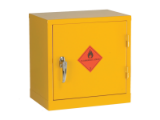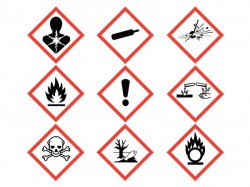 The Globally Harmonised System of Classification and Labelling of Chemicals, also known as GHS, is an internationally recognised system that conforms to consistent criteria regarding the classification and labelling of chemicals.
The Globally Harmonised System of Classification and Labelling of Chemicals, also known as GHS, is an internationally recognised system that conforms to consistent criteria regarding the classification and labelling of chemicals.
Chemical classification is extremely important; it helps you to be aware of how the chemicals you are supplying could potentially harm you, others around you and the environment.
If you are unsure about the legislation regarding the labelling requirements of chemicals you may be handling and supplying, visit the HSE website for more information.
Understanding GHS
The GHS was created by the United Nations, after development began at the United Nations Rio Conference in 1992.
Considering the fact that there used to be a variety of regulations concerning hazard classification being carried out in numerous countries, although these were similar in content, they resulted in multiple meanings for the same hazard in different countries.
With this in mind, it was decided that a worldwide approach to the subject was appropriate, due to the depth of international trade in countries regarding chemicals and hazardous substances.
The GHS adoption in relation to European countries is as follows:
- Published regulation for GHS implementation fell on December 31st 2008
- Substance classification deadline was on December 1st 2010
- For mixtures, the deadline date for implementation is June 1st 2015
The first edition of the GHS was published in 2003 and since then, the system has been updated and edited every two years until 2013. With this being said, it is expected that this year the system will be implemented worldwide.
The benefits of GHS are to generally enhance the protection of human health and the environment – by implementing GHS, this creates an international understandable system for hazard communication.
Another advantage of GHS includes promoting the management of chemicals worldwide – there is finally a unanimous system for a number of countries to follow in order to provide a harmonised basis when identifying hazards and communicating in relation to them in many different countries.
Furthermore, GHS will also help to facilitate trade by reducing the cost and time that was being taken complying with multiple classification and labelling systems, by promoting more stability in regulations.
Having said this, it is suggested that GHS implementation will require extensive training to promote the understanding of these recent labels, however there are multiple manuals and scripts available online discussing the meanings behind GHS.
You can also find information regarding this on the HSE website, which provides a greater understanding regarding the legislation of GHS and existing regulations, confirming how it conforms to European Regulation.
I have outlined the main points of this information below:
After CLP (classification, labelling and packaging of substances and mixtures) came into force in 2009, it affected all UK member States.
The CLP Regulation adopts the GHS across all European Union countries, including the UK.
Although GHS has become a globally recognised system, it is a voluntary agreement rather than a law, therefore CLP allows GHS to become adopted by being a suitable national or regional legal system – making it legally binding.
The GHS system and the CLP system are very similar in regards to the duties of the suppliers and so the existing legislation on the CLP system will be directly applied on all EU member states from 2015.
The rules these member states follow when they are classifying chemicals however will change, with the main point of the adoption of the GHS system relying heavily on the hazard pictograms needing to be adopted, which is what we encourage you to take into consideration.
Obviously, from the stage of their production through to their use, chemicals are extremely dangerous for those handling them, as well as towards the environment. Consequently, the GHS system allows people young and old, of different countries, cultures and languages to have a foundation of information that can be recognised by all when handling hazardous chemicals.
Of course, there are many different types of chemicals that need treating and handling differently. With this in mind, the 2011 edition of GHS by the United Nations explains a lot of information regarding the identification of a number of chemicals and hazardous substances, and how the GHS labels should be used.
There are a few elements included in GHS labelling; hazard statements, pictograms (or symbols) and signal words may be required on certain labels such as pesticides, depending upon their toxicity or hazards of the product, whereas precautionary statements, product identifiers and supplier information are required on all labels.
GHS Labels
GHS symbols are put in place to enhance the protection of people and the environment. By putting these symbols in place, people can see where the harmful chemicals are, allowing them to put the right safety precautions in place before they go near them.
The symbols include (from left to right):
- Health Hazard
- Compressed Gas
- Explosive
- Flammable
- Harmful / Irritant
- Corrosive
- Toxic
- Dangerous for the Environment
- Oxidising

The GHS symbols are available in 3 variations:
- A roll of 250 GHS Labels
- GHS signs; available in magnetic or self-adhesive
If you are looking to purchase some of these labels to comply with GHS, visit The Workplace Depot for our full range of labels; we now supply them in sheet, form or roll format.
These labels are designed for containers, drums or cylinders that may be filled with chemicals or hazardous substances and should be treated cautiously, so don’t forget to check out our range of safety storage.
We also supply a range of safety and security COSHH (control of substances hazardous to health) products, ranging from chemical absorbents to hazardous cabinets.
If you need to purchase some of these labels, please do not hesitate, as from 1st June 2015, suppliers are advised to classify, label and package their chemicals correctly to conform to GHS regulations.
Having said this, it is important to clarify that implementing GHS does not affect potentially existing information on labels – for example, directions of use – (as long as the information does not oppose or undermine from the GHS label information).
We hope you have found this article helpful, particularly if you were unaware of these hazardous labelling legislations beforehand. Please feel free to contact us if you have any questions at keepintouch@theworkplacedepot.co.uk or on any of our social media sites that can be found on the homepage of our website.
Posted in News, Product Updates, Health and Safety